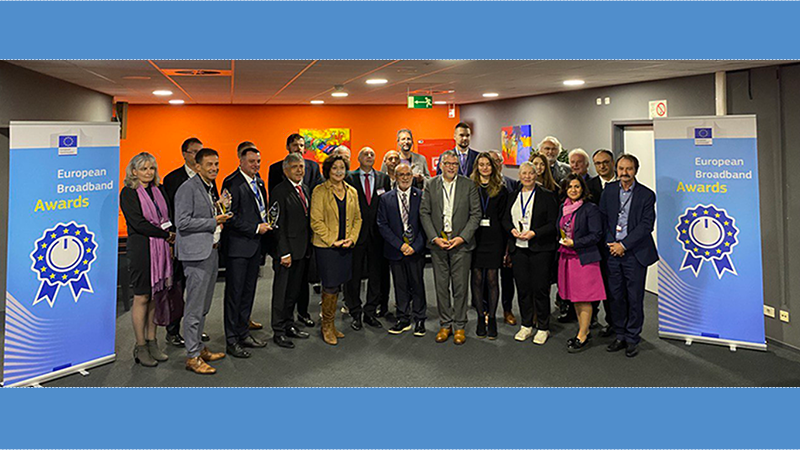EU-funded Connectivity Projects Shine at European Broadband Awards
- 12 Oct 2022

Unprecedented appreciation for Broadband
Reliable, secure and high performance internet connection is key in Europe Digital Transformation. Laying cables and ensuring 5G services grant access to culture, commerce opportunities and ensure social and health services. The infrastructure supporting connectivity can bring together communities, bridge development gaps and open new opportunities for isolated areas.
Two years of COVID-19-induced teleworking and internet-dependent daily life impressed on the world the importance of broadband connection. The lack of reliable internet connection during the pandemic, right when many activities moved on-line, made its most significant impact, unsurprisingly, in isolated and remote areas.
This is why the European Broadband Awards (EBA) shine a much-deserved spotlight on the projects bridging the gaps in internet access, and on the people whose valuable work enables EU citizens to reap the full benefits of a connected society.
EBAs are organized by the European Broadband Competence Office (BCO), a network supported by the European Commission. Its purpose is to assist regional and national authorities in charge of broadband deployment, bringing reliable high-speed broadband connectivity to all EU citizens.
The European Broadband Awards ceremony
The EBA, this year at its 7th edition, are an occasion for the European Commission to acknowledge outstanding European projects. An independent expert jury of five members with comprehensive experience assesses the entries submitted from all over Europe.
Representing best practices in broadband connectivity, the 16 finalist projects were divided in 5 categories that rewarded Innovative models of financing, Cost reduction measures, Socio-economic impact in rural and remote areas; Demand generation and take-up of connectivity and Quality and affordability of services. The jury recognized the efforts of local actors working at ground level – quite literally when laying fiber cables – to connect communities across regions, states and even continents.
After three years of on-line ceremonies, it was only fitting that the finalists and winners of the 2022 EBA would be rewarded during an in-person event in Brussels on the 27 of September. The ceremony was held in front of an audience all too glad to be physically present, despite appreciating better than most the benefits of broadband connectivity.
In line with its commitment to bring together European regions and foster European cohesion, the Directorate General for Regional and Urban Policies (DG REGIO) co-organised the Awards. Some finalists and winners are beneficiaries of EU funding, including via Cohesion Policy instruments.
Connecting Europe
It is the case of two projects similar in their vision, but massively different in terms of scale. BROADEN, partially financed through the ERDF, interconnected the rural area between Sweden and Norway by laying cables between the Torsby municipality in Swedish Varmland county and neighbouring Grue municipality in Norwegian Innlandet. The project won the Jury prize in the category Innovative models of financing, business and investment. Similar in its goal of connecting the EU with non-EU countries is the Europe and Latin America Link (Ellalink) project. The EllAlink won the Jury award for the category reserved to projects stimulating the demand side and increasing the take-up of connectivity.
ELLAlink undertook the remarkable feat of laying 6000 km of cables between Sines in Portugal and Fortaleza in Brazil; connecting also Madeira, Cape Verde and Morocco. Such an undertaking, also benefitting from EU funds, paves the way to untapped commercial opportunities by also linking isolated areas that were previously lacking a reliable internet connection.
Connecting Europeans
European funding also contributed to the success story of the Broadband Master Plan of Navarra 2016-2021, winner of the category “Socio-economic impact in rural and remote areas”. Juan Cruz Cigudosa, Minister for University, Innovation and Digital Transformation of Navarra, stated that being nominated reflects his government full commitment “towards a sustainable, cohesive society” and that this project covers “an entire spectrum of needs from a citizen, governmental and business prospective”. The project unique feature was to provide broadband network access to Navarra’s exceptionally complex demographic distribution. The region’s population is, in fact, very unevenly distributed with more than 10.000 km2 and nearly 650,000 inhabitants, of which approximately one third lives in the capital, Pamplona, and more than half in the metropolitan area. 762 out of 883 municipalities have less than 200 inhabitants, while only nine municipalities have more than 3,000 inhabitants. The success of the project was to tailor the deployment on each territory, identifying the most suitable solutions in terms of technology, infrastructure and investment model. In receiving the prize, the Minister reiterated his belief in “providing the same rights to rural areas as the ones that citizens of cities enjoy”, which echoes DG REGIO’s commitment to leaving no-one behind.
The list of EBA winners supported by the ERDF does not stop there. The award for the category dedicated to Cost reduction measures and co-investment went to the “Digital Nord Pas-de-Calais” project from France. Development Officer for territorial relations of ‘La fibre Numérique 59 62” Mixed Syndicate, Nathalie Ozenne, explains that the added value of their project was “pro-active roll-out of superfast optic fiber broadband in areas not covered by operators”. This way “sparsely populated rural communities are now connected to a network built with public optic fiber”. Kickstarted with private and public French and European funds, the project proved its viability throughout the roll-out, to the point of being increasingly less reliant on public funds and attracting private investors.
The fifth and final category rewarding Quality and affordability of services represented a head-scratcher for the jury which bestowed an ex-aequo award to projects: Breitbandausbau im Landkreis Bautzen from Germany and Broadband Deployment Project "Sankt Nikolai im Sausal from the Austrian region of Styria, the latter also supported by ERDF. Sankt Nikolai im Sausal project intervened in solving a severe market failure in the region enhancing broadband coverage. The project achieved the objective of providing public institutions and businesses with a very high capacity network connection, supplying households with at least 100 Mbps download and increasing the availability of digital services. The creation of the regional broadband Masterplan, that enabled the project, was co-funded by the ERDF. In receiving the prize Gerd Gratzer, Styria Regional Project Coordinator, stated that while “necessary to find private companies to deploy broadband in sparsely populated areas, without ERDF they would not have been able to implement the roll-out in their region”
From smaller to larger scaler, projects supported by the ERDF featured in all the five categories of the Awards. The largest of all ERDF co-funding - €450 million – was provided to a Polish finalist in the demand generation category implemented in 11 Polish regions (Voivodeships) where no modern connectivity existed. No matter the size, the European Broadband Awards set an example of best practices in promoting connectivity in areas not served by the market so that every citizen could benefit from opportunities offered by the digital transition and escape digital divide.
No digital transition without remote areas
The European Broadband Awards were an opportunity for Director for Connectivity at the DG for Communication Networks, Content and Technology (CNECT), Rita Wezenbeek, to introduce Europe’s Digital Decade. Ms Wezembeek stressed how the awards set examples of best practices in the field of connectivity. Such examples show how business models can be re-engineered, how connectivity impacts research, how public services can increase their efficiency even in rural areas.
Europe Digital transformation relies on providing EU citizens with high-performance connection and 5G services. However, this new transition should not widen the gap between urban and rural areas, isolated or sparsely populated regions. In his introduction to the ceremony, Mario Milouchev, Director for CAP Strategic Plans II from Directorate-General for Agriculture and Rural Development (DG AGRI) praised the engagement of local representatives present in the audience, stressing how successful broadband projects can make rural areas more “vibrant and prosperous” in overcoming structural challenges.
This is all the more true when considering the strides towards better services, the opportunities for growth and the potential for innovation that these areas can unlock with access to reliable internet connections. The many finalists and winners supported by the ERDF put forward REGIO’s number one priority of reducing inequalities between communities across Europe.


